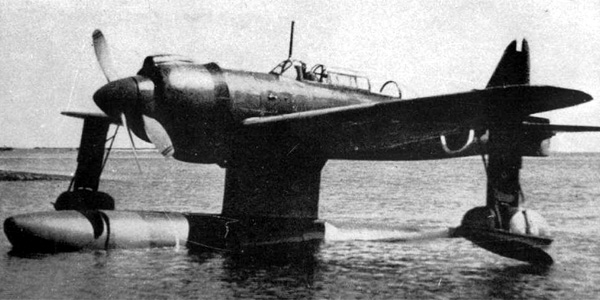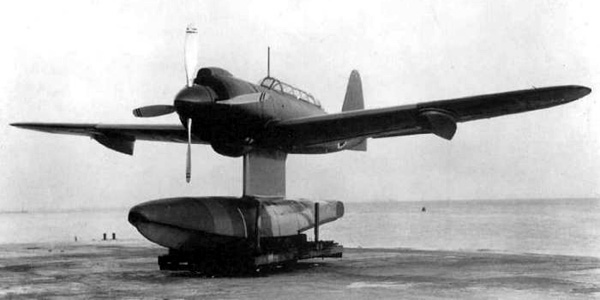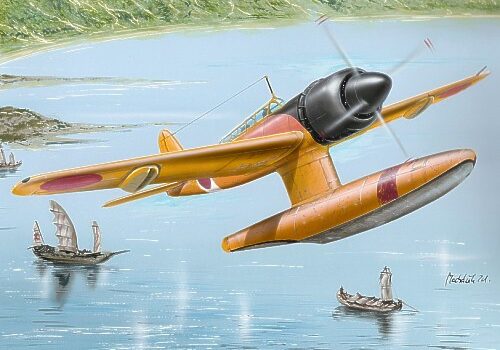Development
In 1939 the Imperial Japanese Navy instructed Kawanishi (a well known lead manufacturer and designer of floatplanes and flying boats) to develop a two-seat high-speed reconnaissance floatplane. The main specifications were on one hand, having sufficient performance to escape interception from land based fighters (1939 standard, 450 kph) and capable of a 800-nautical mile range (1,480 km). It was planned for new class of cruisers (the Ibuki class, lead vessel reconverted as a light carrier, but never completed) and the light cruisers intended to lead (as flagships) submarines squadrons. Each was to carry six of these new Kawanishi models to screen for the submarines, in search of targets. But unlike the Ibuki, only the first was ever completed, IJN Ōyodo, ordered at the same time in 1939. Each Ibuki (larger ships) would carry two of the new floatplane as well.
The first prototype was called E15K1 (Navy short designation system), presented with a countra-rotative propeller, something quite new in Japan and in the world in 1940. It did its maiden flight on 5 December 1941. This was successful enough that the admiralty ordered Five more prototypes, built during 1941 and 1942 with gradual improvements. Here it shows already how long this project dragged on. Development was protracted indeed due to the numerous E15K1 innovative features, and new issues surged at each flight, that in turn led to modifications, so much so that the whole program fell behind schedule. Among other the retractable stabilizing floats proved troublesome, broke and provoked several accidents when they could not be lowered for landing. In the end, the whole retractable system was dropped and stabilizing floats were made fixed. In 1942 also Mitsubishi’s aero engine department progressed, and presented the more powerful MK4S Kasei 24. It was fitted to compensate for increased drag, but needed to redesign the cowling, fuselage structure, and fuel line.
Design
Kawanishi designed a single-engine monoplane, low-wing and centred around a 1,460 hp (1,090 kW) Mitsubishi MK4D Kasei 14. This 14-cylinder radial was unusual as it drove two contra-rotating, two-bladed propellers (which oddly seemed like a step back). This was a first. The concept was being tried also in Europe, but was never implemented until late in the war. It presented multiple advantages, notably torque balancing and extra propulsion.
The new floatplane had also a single central float, plus two retractable stabilizing floats under wings, initially to reduce drag. More so, the main central float was designed to be jettisoned in emergency as it boosted top speed to 50 knots (90 km/h) more, judged enough to escape 1941 generation fighters (like the Wildcat). Wings had a refined laminar flow airfoil section, to further reduce drag. Like the Kawasaki Ki-100, the fuselage was refined to make a clean transition between the bulk of the radial engine and the rest of the fuselage. The canopy and engine cowling were also long refined in wind tunnel.
Detailed specs
specs |
|
| Crew: | 2: Pilot, Observer/navigator/MG gunner |
| Fuselage Length | 11.587 m (38 ft 0 in) |
| Wingspan | 14 m (45 ft 11 in) |
| Wing area | 30 m2 (320 sq ft) |
| Height | 4.95 m (16 ft 3 in) |
| Empty weight: | 3,165 kg (6,978 lb) |
| Gross weight/Max TO: | 4,100 kg (9,039 lb)/4,900 kg (10,803 lb) |
| Propeller: | 4-bladed contra-rotating constant-speed propeller |
| Engine: | Mitsubishi MK4S Kasei 24 14-cyl. ACRPE 1,380 kW (1,850 hp) TO |
| Top speed: | 469 km/h (291 mph, 253 kn) at 5,700 m (18,700 ft) with float |
| Climb rate: | 6,000 m (20,000 ft) in 10 minutes |
| Endurance: | 3,371 km (2,095 mi, 1,820 nmi) at 296 km/h (184 mph, 160 kn) |
| Service ceiling: | 9,830 m (32,250 ft) |
| Wing Loading: | 136.7 kg/m2 (28.0 lb/sq ft) |
| Power/mass: | 0.335 kW/kg (0.204 hp/lb) |
| Armament: MGs | 7.7 mm (0.303 in) Type 92 machine gun in rear cockpit |
Service
All these problems were eventually revolved, as the E15K1 was ordered into limited production (pre-production batch) as the “Navy Type 2 High-speed Reconnaissance Seaplane Shiun Model 11”. Six were delivered and trialled as E15Ks, evaluated in 1942. Production was greenlight in early 1943, but the first operational E15K1 only arrived by April 30, 1944, and six first models were assigned to the 12th Reconnaissance Squadron, 61st Air Flotilla. In between, the Oyodo class were cancelled (apart the lead ship, also completed in 1943). So the need for more was not that urgent.
On June 1, the first early Shiuns arrived at Palau, South Pacific. But by that stage, the Grumman Hellcat had long replaced the Wildcat, seconded by the excellent Vought F4U Corsair. Both were about 150 kp faster than the Shiun. Compounded with the inexperienced of the crews this was already an issue. But more son was the immense frustation if pilots that realized the vaunted “float trick” did not worked in practice.
The main float jettison mechanism was wind-tunnel tested, but in actual trials, and just time and again refuse to work. With this, the new E15K1 had unusually high maintenance and proved still troublesome in operations in many areas. Given the reports, the Navy brass decided to cut down production in February 1944. This left only 15 Shiuns completed, six prototypes and eight production models. Two were planned to serve on IJN Oyodo and the Mogami class, but due to their poor performances the Aichi E13A1 “Jake” was used instead.
Gallery

E15K on the cruiser IJN Oyodo, 1944



Read More/Src
Books
Francillon, René J. (1979). Japanese Aircraft of the Pacific War (2nd ed.). Putnam & Company.
Green, William (1962). War Planes of the Second World War: Volume Six, Floatplanes. London: Macdonald & Co.
Jackson, Robert (2002). The Encyclopedia of Military Aircraft. Bath: Parragon.
Layman, R. D.; McLaughlin, Stephen (1991). The Hybrid Warship. London: Conway Maritime Press.
Millot, Bernard (May 1978). “Kawanishi E15K1 “Shiun” (Norm) Fana de l’Aviation (in French) (102) 42–45.
“61st Air Flotilla, 12th Recon Sqn wartime report No.1-3.”, Japan Center for Asian Historical Record (in Japanese)
Links
airpages.ru
secretprojects.co.uk/
aviastar.org
pacificwrecks.com
daveswarbirds.com
avionslegendaires.net
airwar.ru/
en.wikipedia.org
combinedfleet.com


 Latest Facebook Entry -
Latest Facebook Entry -  X(Tweeter) Naval Encyclopedia's deck archive
X(Tweeter) Naval Encyclopedia's deck archive Instagram (@navalencyc)
Instagram (@navalencyc)





 French Navy
French Navy Royal Navy
Royal Navy Russian Navy
Russian Navy Armada Espanola
Armada Espanola Austrian Navy
Austrian Navy K.u.K. Kriegsmarine
K.u.K. Kriegsmarine Dansk Marine
Dansk Marine Nautiko Hellenon
Nautiko Hellenon Koninklije Marine 1870
Koninklije Marine 1870 Marinha do Brasil
Marinha do Brasil Osmanlı Donanması
Osmanlı Donanması Marina Do Peru
Marina Do Peru Marinha do Portugal
Marinha do Portugal Regia Marina 1870
Regia Marina 1870 Nihhon Kaigun 1870
Nihhon Kaigun 1870 Preußische Marine 1870
Preußische Marine 1870 Russkiy Flot 1870
Russkiy Flot 1870 Svenska marinen
Svenska marinen Søværnet
Søværnet Union Navy
Union Navy Confederate Navy
Confederate Navy Armada de Argentina
Armada de Argentina Imperial Chinese Navy
Imperial Chinese Navy Marinha do Portugal
Marinha do Portugal Mexico
Mexico Kaiserliche Marine
Kaiserliche Marine 1898 US Navy
1898 US Navy Sovietskiy Flot
Sovietskiy Flot Royal Canadian Navy
Royal Canadian Navy Royal Australian Navy
Royal Australian Navy RNZN Fleet
RNZN Fleet Chinese Navy 1937
Chinese Navy 1937 Kriegsmarine
Kriegsmarine Chilean Navy
Chilean Navy Danish Navy
Danish Navy Finnish Navy
Finnish Navy Hellenic Navy
Hellenic Navy Polish Navy
Polish Navy Romanian Navy
Romanian Navy Turkish Navy
Turkish Navy Royal Yugoslav Navy
Royal Yugoslav Navy Royal Thai Navy
Royal Thai Navy Minor Navies
Minor Navies Albania
Albania Austria
Austria Belgium
Belgium Columbia
Columbia Costa Rica
Costa Rica Cuba
Cuba Czechoslovakia
Czechoslovakia Dominican Republic
Dominican Republic Haiti
Haiti Hungary
Hungary Honduras
Honduras Estonia
Estonia Iceland
Iceland Eire
Eire Equador
Equador Iran
Iran Iraq
Iraq Latvia
Latvia Liberia
Liberia Lithuania
Lithuania Mandchukuo
Mandchukuo Morocco
Morocco Nicaragua
Nicaragua Persia
Persia San Salvador
San Salvador Sarawak
Sarawak Uruguay
Uruguay Venezuela
Venezuela Zanzibar
Zanzibar Warsaw Pact Navies
Warsaw Pact Navies Bulgaria
Bulgaria Hungary
Hungary

 Bundesmarine
Bundesmarine Dutch Navy
Dutch Navy Hellenic Navy
Hellenic Navy Marina Militare
Marina Militare Yugoslav Navy
Yugoslav Navy Chinese Navy
Chinese Navy Indian Navy
Indian Navy Indonesian Navy
Indonesian Navy JMSDF
JMSDF North Korean Navy
North Korean Navy Pakistani Navy
Pakistani Navy Philippines Navy
Philippines Navy ROKN
ROKN Rep. of Singapore Navy
Rep. of Singapore Navy Taiwanese Navy
Taiwanese Navy IDF Navy
IDF Navy Saudi Navy
Saudi Navy Royal New Zealand Navy
Royal New Zealand Navy Egyptian Navy
Egyptian Navy South African Navy
South African Navy






























 Ukrainian Navy
Ukrainian Navy dbodesign
dbodesign